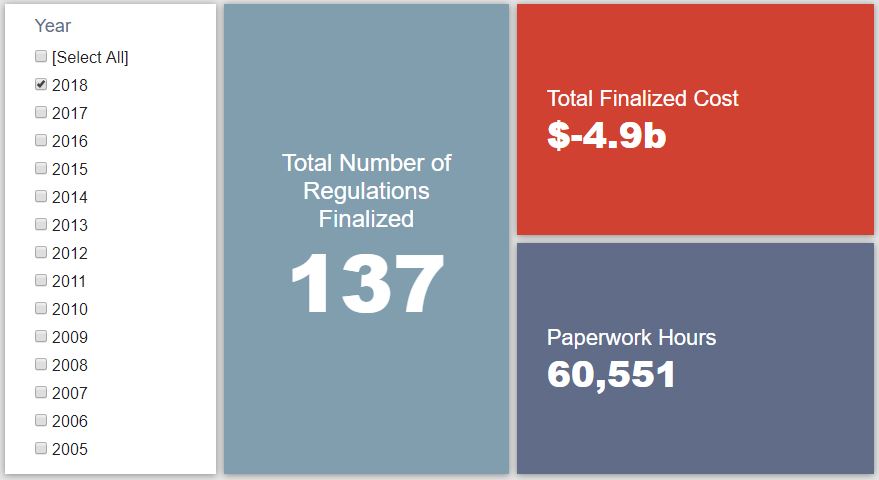Week in Regulation
July 2, 2018
Deregulatory Actions on The Move
After a string of weeks that saw net cost increases, this past week in federal rulemaking came out on the cost-cutting side. The Department of Transportation (DOT) led the charge with the two most notable deregulatory measures of the week. Between both proposed and final rules, agencies published roughly $350.3 million in net cost savings and 161,839 hours of new paperwork. The per capita regulatory burden for 2018 is negative $14.84.
Regulatory Toplines
- New Proposed Rules: 47
- New Final Rules: 96
- 2018 Total Pages of Regulation: 30,597
- 2018 Final Rules: -$4.9 Billion
- 2018 Proposed Rules: $8.8 Billion
Tracking Regulatory Modernization
Different DOT sub-agencies produced the most significant deregulatory actions of the week. The Federal Motor Carrier Safety Administration (FMCSA) proposed a rule regarding “ELDT; Commercial Driver’s License Upgrade From Class B to Class A.” The proposal seeks “to reduce the training time and costs” it takes a “Class B” driver to qualify for a “Class A” license. FMCSA estimates that this could save affected drivers $212 million in total present value savings ($15 million annualized). The other DOT measure comes from a Federal Aviation Administration (FAA) final rule. The rule makes a variety of changes to pilot training and certification regulations. FAA estimates that these changes could produce $113.5 million in savings over five years, or $22.7 million in annualized savings for the purposes of the Executive Order (EO) 13,771 regulatory budget.
There was one regulatory action under the auspices of EO 13,771 as well. The Environmental Protection Agency (EPA) measure updates “Reporting Requirements for the TSCA Mercury Inventory.” While it is a regulatory action, it pales in comparison to the savings noted above. EPA estimates that the rule’s changes bring roughly $10 million in new costs ($1.7 annually). EPA is still on track to surpass its EO 13,771 goal for Fiscal Year (FY) 2018 of $40 million in net annual savings. Per American Action Forum (AAF) tracking, among rulemakings applicable to EO 13,771 that include quantified economic estimates, the agency currently sits at roughly $60 million in net annual savings.
According to AAF analysis, since the start of FY 2018 (beginning Oct. 1, 2017), executive agencies have promulgated 41 deregulatory actions with quantified estimates against seven regulatory measures that impose costs, under the rubric created by EO 13,771 and the administration’s subsequent guidance document on the matter. These rules combine for net annual savings of roughly $1.2 billion. This means that agencies have thus far surpassed the administration’s cumulative goal for FY 2018 of $687 million in net annual savings. In fact, according to the administration’s latest Unified Agenda, agencies are on track to roughly double that goal.
Click here to view AAF’s examination of the administration’s progress under the “one-in, two-out” executive order through the end of Fiscal Year 2017.
State of Major Obama-Era Initiatives
Based on total lifetime costs of the regulations, the Affordable Care Act has imposed costs of $52.9 billion in final state and private-sector burdens and 176.9 million annual paperwork hours.
Since passage, the Dodd-Frank financial reform legislation has produced more than 82.9 million final paperwork burden hours and imposed $38.9 billion in direct compliance costs.
Total Burdens
Since January 1, the federal government has published $3.9 billion in net costs (despite $4.9 billion in net savings from final rules) and new paperwork burdens amounting to 2.3 million hours (including 60,551 new hours from final rules). Click here for the latest Reg Rodeo findings.











